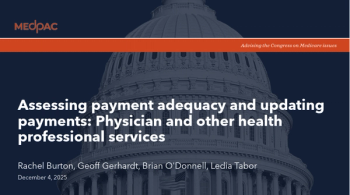
Helping patients with brand name drug costs
In my last article, I discussed how doctors can help patients obtain low-cost generic medications by operating
My Direct Primary Care (DPC) practice focuses on care for such patients: 75 percent of all our patients either have no health insurance, or only a high-deductible catastrophic policy, including
Fortunately, there are ways to help these patients.
The first thing to do is to consider whether the patient’s brand-name medication can be changed to something generic, or even be stopped completely. Now, this may sound like a “Captain Obvious” suggestion, but with so much to do during a short office visit, sometimes medications just get automatically renewed without much consideration of cost.
For example, a patient may have received samples of the latest-and-greatest drug. When the samples run dry, their physician sends a prescription to the pharmacy, without realizing just how expensive the medication is. In some cases, a less-expensive older version of the same class of medication will work just as well for the patient’s symptoms.
It is also helpful to consider what medications may be able to be “deprescribed,” for example, if they are no longer medically necessary or consistent with the patient’s goals of care.
But let’s imagine that you have determined that a patient really and truly needs an expensive brand-name medication, and there is no reasonable generic substitute. Here is what I do.
1) Rely on samples
I don’t get as many pharmaceutical sales visits as I used to when I had a larger Medicare and insurance population, but when I do see my sales reps, I hit them up for as many samples of my most-needed medicines as I can get. I also visit manufacturer websites and request samples through their online forms-this is particularly helpful for obtaining insulin samples for patients. Of course, the downside to samples is that eventually the demand may exceed your supply. In this case, the next step is to turn to coupons and special programs.
2) Use coupons
The best thing about free trial coupons is that anyone can use them, even patients with Medicare and Medicaid. The downside is that these coupons can usually be used only once, and they aren’t offered for all medications. Nonetheless, it’s worth checking the drug maker’s website to see if they have a free month trial for the medication you are seeking-and write for a stronger dose of the medication for the patient to split when possible.
Discount manufacturer coupons or copay assistance cards are usually most helpful for patients with conventional insurance. They cannot be used by patients with any government insurance like Medicare, Tricare, or Medicaid. In the case of a high-deductible insurance plan, they may not be useful at all, as the assistance is usually capped at a certain annual amount-but it is often worth trying the card to see how low the price can go.
3) Apply for patient assistance programs
Almost every pharmaceutical company offers medications for free to those who financially qualify. Each company has its own application and requirements-the best thing to do is to go directly to the manufacturer’s website and find their application. Don’t go through advertised programs that are supposed to help you find patient assistance programs-these are usually middlemen and are sometimes promoting discount cards or other products.
Patient assistance programs usually require that applicants have proof of limited or no prescription coverage, financial need, and US residency. Patients with Medicare Part D who have hit the “donut hole” or whose drug expense are more than 5% of their household income may also qualify for assistance.
The financial criteria depends on the company and can vary from 200% below the Federal Poverty Level (equivalent to about $25,000 per year for an individual, or $51,500 for a family of 4) to 500% of the Federal Poverty Level for other drug-makers (about $50,000 for an individual and $103,000 for a family of 4).
The amount of proof required can be as simple as a checkbox acknowledging that the patient meets the qualifications or may require paperwork like a tax return or check stubs, depending on the company’s policy.
In general, physicians must fill out a portion of the patient assistance program application and sign the form. The forms are usually quite simple, and the programs often have excellent customer assistance. Medications are either shipped to the physician’s office or to the patient directly. In some cases, patients receive a card or voucher to take the pharmacy to receive their medication. I have had incredible success in helping my patients obtain free medications from multiple pharmaceutical companies, including year supplies of diabetes medications, biologic agents for autoimmune disease, and even two patients who received free treatment for Hepatitis C ($80,000 value per treatment) and are now cured of the disease.
4) Apply for insurance/ Medicaid
I always encourage my patients to visit the insurance exchange at HealthCare.gov. Low income patients may find that they qualify for Medicaid and will now be able to obtain brand name drugs for free or at very low cost. In some cases, they qualify for a subsidy to a conventional insurance program. It’s always worth a try.
5) Getting help for undocumented residents
My biggest challenge in my present population are patients who are not in this country legally. Patient assistance programs generally will not provide medication to non-US residents. Right now, my best strategy is to use generics and try to hoard my samples when brand-name is necessary. While it is not currently legal to obtain medication from outside the US, there are mail-order pharmacies from Canada that can provide branded drugs at about one-third to one-half the cost. Currently legislators are debating allowing patients to import these lower-cost medications, but the debate is still ongoing.
Editor's Note: Blogs are contributions from members of the medical community and other experts. These blogs are an opportunity for bloggers to engage with readers about a topic that is top of mind, whether it is practice management, experiences with patients, the industry, medicine in general, or healthcare reform. The opinions expressed here are that of the authors and not Medical Economics.
Newsletter
Stay informed and empowered with Medical Economics enewsletter, delivering expert insights, financial strategies, practice management tips and technology trends — tailored for today’s physicians.














